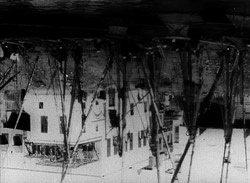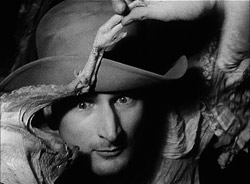





New Yorker Ken Jacobs is the eternal radical of independent film. His life’s work has been an untiring aesthetic, social and physical re-evaluation of the moving image. Jacob’s provocative opinions and his near-militant speech about cinema’s rejected possibilities created him a reputation as a bad boy in 1960s New York. Time, however, has done its work. Nowadays Jacobs is a celebrated figure, even showing up on the Whitney Museum’s list of the 20th century’s most important artists.
Jacobs’s films awaken in viewers the same feelings of mystery and amazement as the first moving picture displays did at the end of the 19th century. Jacobs has always revelled in the subconscious potential of found material: Perfect Film consists of unedited found footage of a tv reportage. The reel includes, among other clips, spontaneous interviews with eyewitnesses to Malcolm X’s assassination. In the trance films Let There Be Whistleblowers and Opening the Nineteenth Century: 1896, the manipulated movements of trains blur time and place. Nymph, Capitalism: Slavery and Capitalism: Child Labor operate in the magic realm of old stereo photographs. Working on the same dark side of awareness are the disturbed fantasies Globe and The Doctor’s Dream. Using Thomas Edison’s innocent short from 1903 of a carousel as its starting point, Razzle Dazzle: The Lost World depicts the hysterical derailing of the American paradise as it spins through time. In the cult films The Whirled and Blonde Cobra, the world is already turned on its head. In both films, the charismatic Beat icon Jack Smith romps about in the lead role. Jacobs’s monomaniacal works are like sculptures, shimmering in time, from the unknown areas of consciousness. Some of the films can be experienced only with the help of Pulfrich filters, which will be provided to the audience.
Atmospheres and Deep Silence are Nervous Magic Lantern events, in which Jacobs, along with his wife Flo, present moving images without film or video, instead using hand-painted glass plates. The Jacobs’s live performances have been described as a cross between an improvised jazz concert, shadow theatre and hypnosis.
Ken Jacobs will also give an audience lecture about his work.
[Please note! These films contain powerful strobe effects which could cause headaches or epileptic symptoms.]
Ken Jacobs’s films will be shown at the Kiasma Theatre (Mannerheiminaukio 2, tel. +358 9 17336501). Tickets are €4 for each showing. Admission to the saturday lecture is free.
Friday, 21 November
6:00 p.m. Ken Jacobs 1
The Whirled (1956–1961, 16 mm, 15 min)
Perfect Film (1985, 16 mm, 22 min)
Blonde Cobra (1959–1963, 16 mm, 30 min)
Nymph (2007, dvd, 3 min)
Pushcarts of Eternity Street (2006, dvd, 10 min)
Capitalism: Slavery (2006, dvd, 3 min)
Capitalism: Child Labor (2006, dvd, 3 min)
Total running time: 86 min.
Saturday, 22 November
1:00 p.m. Ken Jacobs 2
Opening The Nineteenth Century: 1896 (1990, 16 mm with Pulfrich filters, 9 min)
The Doctor’s Dream (1978, 16 mm, 23 min)
Globe (1971, 16 mm with Pulfrich filters, 22 min)
Let There Be Whistleblowers (2006, DVD, 18 min)
Krypton Is Doomed (2005, dvd, 34 min)
Total running time: 106 min
3:00 p.m. Ken Jacobs: Artist’s talk
5:00 p.m. Ken Jacobs 3
Razzle Dazzle: The Lost World (2006–2007, dvd, 93 min)
7 p.m. Ken Jacobs 4
Atmospheres (2008, The Nervous Magic Lantern, approx 60 min,
performed live together with Flo Jacobs)
Sunday, 23 November
3 p.m. Ken Jacobs 5
Return To The Scene of The Crime (2008, dvd, 98 min, sound)
5 p.m. Ken Jacobs 6
The Scenic Route (2008, 25 minutes)
Anaglyph Tom (Tom with Chubby Cheeks) (2008, approx 80 min)
*world premiere*
Total running time: 105 min
7:30 p.m. Ken Jacobs 7
Deep Silence (2008, The Nervous Magic Lantern, approx 60 min,
performed live together with Flo Jacobs)
From Friday, 7 November to Sunday, 30 November
Ken Jacobs
Star Spangled to Death (2004)
Ken Jacob’s Star Spangled to Death, infused with a beatnik spirit, is a testament of 20th century America. The project began way back in 1957, growing out of the cosmic costume and role improvisations of Jack Smith, Jerry Sims and a few other underground visionaries. Due to a non-existent budget and broken-down conditions, shooting on the film progressed in fits and starts during the 1960s and 1970s. In 2004, thanks to the participation of Jacobs’s daughter Nisi, it was at last completed.
At the heart of the nearly seven-hour epic are the staged passages shot by Jacobs, which are then juxtaposed with baffling archival footage from the history of the moving image. The work makes use of clips from animation, educational movies, news reports, propaganda films – even Richard Nixon’s famous 1952 “Checkers speech” appears in its entirety. Star Spangled to Death works on two levels: as an ethically unforgiving declaration on behalf of individualism and freedom of speech, and as a subtle depiction of what personal cinema, at its core, can be.
From 7 November to 30 November, Star Spangled to Death will be shown at the Kiasma Mediatheque, from Wednesday to Sunday, 11 a.m. to 6:30 p.m. Running time: 6 hours and 40 minutes. Entry with a Kiasma (Mannerheiminaukio 2, tel. +358 9 17336501) ticket or, from 21 November to 23 November, with a ticket to the Kiasma Theatre showing of Ken Jacobs’s films.